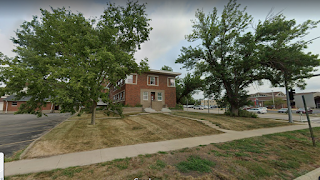 |
| That was then, looking north (Google Earth screen capture) |
This week's demolition of the mid-century convent building at the corner of 4th Avenue and 10th Street SE is a seminal example of the tension between individual rationality and collective irrationality. Save CR Heritage, our local historical preservation warriors, documented the demolition on their Facebook page. Cindy Hadish, Save CR Heritage secretary--and author of the Homegrown Iowan blog--said the organization had sought a 60-day hold on demolition through the city's Historic Preservation Commission, but the commission had not acted on the request before the building was demolished.
 |
| This is now, looking east |
There is no mention of the demolition on the Immaculate Conception Church website. According to Save CR Heritage, the church had deemed the building a "liability" because it had been unoccupied for some time, and that plans are to use the space for additional parking. The convent was added to the church campus in the 1950s; the present building and adjoining Scotus Hall were built in the early 20th century ("The First 100 Years--1858 to 1958").
It may be that the church can use the parking. Their current parking lot is small; when I've attended Sunday events at the church, people park across 3rd Avenue in the Physicians Clinic of Iowa lot, but that may not be practicable during the week. Others among Cedar Rapids' historic 3rd Avenue churches, including my own, have over time taken down buildings to expand parking. Most of these churches draw members from all over the metropolitan area, and most of those members need somewhere to put their cars while they worship. The city has a stake in the success of all its institutions, and the churches, medical facilities, and businesses along 3rd all need parking for their driving visitors.
On the other hand, Cedar Rapids' core, and in particular the area designated as the MedQuarter in which many historic churches reside, is awash in surface parking. It is particularly noticeable along 4th Avenue:
.png) |
| 4th Avenue, looking downtown from 10th Street (Google Earth screen capture) |
And this is not a case where 4th Avenue is "taking one for the team," handling the parking so other streets can be great, like Heivly Street in Decorah or 2nd Street SE here (Kaplan 2016a); the parallel streets through the MedQuarter are also laden with parking lots and unfriendly buildings.
The city has a stake in the vibrancy of its core, too. And the way parking competes with all other uses makes it the enemy of good development. (See Shoup 2005, Kaplan 2016b, or really any published urbanist.) Save CR Heritage argues the convent building could have been used for housing. Surface parking puts destinations farther apart, making walking less desirable, the neighborhood less interesting, and adding to the city's infrastructure maintenance load (paid for by you, whether you're driving or not). The more driving is accommodated, the more cars are brought into the area, the less safe it is for everyone else, and the more the planet suffers.
The conflict between parking and other community interests is not symmetric. If all the churches, medical facilities, and so forth want more parking, we have seen they will get it, even demolishing buildings or buying adjoining properties to obtain it. But who speaks for the countervailing interests? Organizations like Save CR Heritage (and Corridor Urbanism) can advocate, but have no power to back it up. Only the city government can act for collective interests with long-term, widely diffused benefits. Can they limit, through zoning, the amount of land devoted to parking lots? Block sales of homes to institutions without a plan for using or replacing those structures? Broker parking lot-sharing agreements?
Governments, of course, are far from perfect. They are far from perfect advocates for collective goods. They have their own incentives. Often they respond to the loudest, most powerful voices in the room, which is the main reason Adam Smith didn't like public spending. Governments like flashy things, like a new casino, or a spiffed-up Field of Dreams, which is getting showered with public money in spite of accumulated evidence the return on investment is likely to be disappointing (Ionescu 2022, Welch 2022). They would rather build new roads than fix the ones we've got (Marohn 2022). Meanwhile, Iowa is ending a program of rental and utility assistance; outsiders like the poor don't have the political heft of insiders.
And yet, without someone to balance the scales by standing up for public interests, the community is merely the pursuit of private interests. Private interests are not all bad--Smith also points out that the brewer's and the baker's private interest in living well gets me beer and bread--but if that's all we have to go on, we get short-term thinking and long-term desolation.
SEE ALSO:
"Filling in an Empty Quarter (III)," 25 July 2014
"Indulging in Urban Fantasy," 6 September 2014
"Why Historic Preservation," 22 July 2013
"The Future of Downtown Cedar Rapids," 24 June 2022




No comments:
Post a Comment